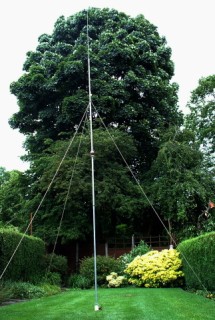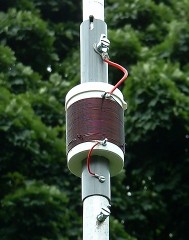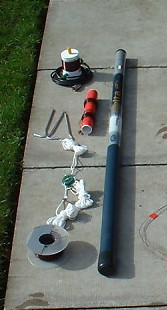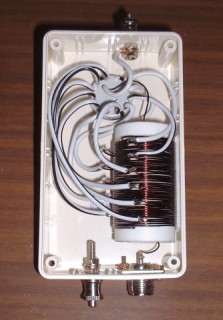
Having had some success with "short" (8ft-long!) mobile aerials for ground-wave contacts on 160m, I was intrigued by the idea of making something a little larger for portable use.
I've made a number of versions of this antenna, which have now diverged into two variants:
1. the loaded vertical (see below);
2. the top-loaded inverted-L.
The diagram below shows the basic design, which comprises two vertical sections, joined by a loading coil, and an adjustable matching coil at the base:

The vertical sections may comprise either a conducting metal mast (which must be insulated at the base, and around the loading coil) or wire wrapped around an insulating mast (such as a fishing rod).
For best efficiency, the loading coil must be as high as possible off the ground, but this requires a compromise between the inductance (and hence size and weight) of the coil and the length of the top section.
The antenna will have a small bandwidth (in the order of tens of kilohertz) and so will need to be adjusted for the particular operating frequency. Aim to make the antenna resonant on the highest frequency of interest, and then adding an adjustable coil at the base will allow it to be tuned to lower frequencies.
The resonance is mainly governed by the combination of the loading coil and the top section (acting as a resonating capacitance). The length of the bottom section makes little difference to the resonance, but affects the efficiency and bandwidth.
Like all vertical aerials, some kind of ground system is required, and the better the earth, the better the performance of the antenna.
Converting a mastMy first design used a tubular aluminium portable mast, with a new insulating section added where the loading coil is fitted. This produced a self-supporting (guyed) structure about 20ft high, which can collapse down into component parts which may be carried easily in the boot of a car, or in a shoulder-bag. The lower section of this antenna had a total length around 2.8m, and a telescopic rod aerial was added at the top, so that the top section can be adjusted between 2.1 and 3.1m (this allows the effective capacitive loading of the top section to be varied, in order to provide "coarse tuning" across the band). Comparative tests on the prototype aerial in a small enclosed garden yielded signals up to 8dB stronger with local stations than on a co-sited end-fed 130ft horizontal wire. More distant (sky-wave) stations were better on the wire. |
 |
 |
To resonate this antenna, a centre-loading coil of around 200uH was required. This was achieved by winding 70 turns of 21 SWG enamelled wire around a plastic tube 64mm in diameter. This tube was fitted over the insulating section at the centre of the mast, and the ends connected to the upper and lower mast sections. The base of the antenna was isolated from ground by standing it on an insulating plastic container, and an adjustable series inductor is installed at the base, for easy tuning. |
To allow fine adjustment of the resonant frequency without lowering the antenna, a small "roller-coaster" inductor was added in series between the base of the mast and the feed point: increasing this inductor lowers the resonant frequency of the antenna. Further "coarse tuning" can be achieved by adjusting the telescopic rod at the top, so that the resonant frequency can be tuned across the whole band 1.81 to 2.0MHz. The final component of the antenna (which is not visible in the photos) is a counterpoise wire, which is attached to the base-plate, and then laid out around the area. The more wires the better, but the initial experiments only used one, around 60 ft in length. |
 |
 |
A converted fishing rodA second version of this design uses a 9m telescopic fishing rod. Here, the radiating elements consist of a couple of lengths of 22SWG wire, loosely wrapped around the rod. The loading coil comprises around 175 turns of the same wire on a section of 31mm PVC waste pipe, which slides over the rod about two-thirds of the way up. This antenna was resonated at about 2.0MHz, so a tapped base-loading coil is then used to tune it across the amateur band. Counterpoise wires are laid out on the ground, and attached to the feeder near the base of the antenna. |
 |
The entire kit is lightweight enough to be carried to a portable site, and can be set up single-handedly in about quarter of an hour. Using the internal VSWR meter built into the FT817, the tapping points on the base coil can be quickly adjusted to tune the antenna on the chosen frequency. I've now built a more waterproof tapped coil, using a 12-position switch enclosed in an ABS box.
|
 |
Apart from improving the earth system to include more wires and a couple of copper rods sunk into the soft ground, I've recently tried rasing the height of the loading coil (thus extending the radiating vertical section).
The loading coil now sits at the top of the mast, with the resonating wire suspended from this, and anchored by a long nylon cord to a convenient point.
The aerial has therfore mutated into a top-loaded inverted-L.